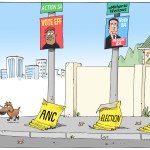ECONOMIC OUTLOOK ANALYSIS
SA Reserve Bank is exorcising the spectre of stagflation

The South African Reserve Bank is unlikely to cut interest rates in the near future.
A spectre is haunting the South African economy – the spectre of stagflation.
The South African Reserve Bank (Sarb) is the one arm of the state that stands between the economy and this demonic force. And that is why it is unlikely to cut interest rates any time soon.
Stagflation grips an economy when it is afflicted by a trifecta of woes that orthodox economic theory once held should not occur simultaneously: high inflation, high unemployment and a low rate of economic growth or contraction.
If unemployment is low, inflation should be frothy because the vast majority of the working-age population has a steady income, underpinning demand for goods and services.
A tight labour market also lifts wages – a cost to business that must be absorbed or passed on to consumers – as workers can be fussy about who they work for and the compensation they receive for their labour. This in turn fuels inflation.
The backdrop here is typically economic growth that has shifted into a high gear.
By contrast, if unemployment is high, inflation should be subdued, as demand will recede and wage hikes slow as the bargaining power of employees erodes. The backdrop here is usually an economy that has shifted into a lower growth gear.
The relationship between unemployment and inflation in this classical modelling is inverse.
In South Africa, the unfolding failure of the state and policies that are often poor and confusing have combined to put a brake on economic growth while sending unemployment into world-topping territory.
Economic growth has been sluggish for years and was only 0.6% in 2023.
A recession was narrowly dodged by the thinnest of margins at the end of last year, and in 2024 the economy is expected to grow between only 1% and 1.5%.
Unemployment by its widest definition is well over 40%, and so there are no significant demand pressures in the economy to feed inflation. But some of the key reasons for this crisis – the power shortages, the logistical meltdown and rampant crime – are contributing to inflation by significantly raising the cost of doing business.
Diesel for generators or solar panel installation, added transport costs and the heavy costs of security all get passed on to consumers. And slow economic growth and policy uncertainty do nothing for the rand’s exchange rate, which is why it is so costly to import crucial products like oil.
To top it all off, El Niño has seared South Africa’s staple maize crop, raising the grim prospect of food inflation again accelerating after it had been slowing for months.
South Africa’s maize production is forecast to fall over 19% in 2024 to 13.255 million tonnes from the bumper harvest of 16.43 million tonnes that was reaped last year, the Crop Estimates Committee (CEC) said on 26 March.
This is largely a consequence of droughts linked to the El Niño weather pattern, which is sweeping a scythe of misery across southern Africa.
The big concern is the outlook for staple white maize, the main source of calories for many poor and working-class households in South Africa and the region.
The CEC pegged white maize output at 26% or 6.277 million tonnes lower in 2024 – a forecast that is likely to have grim implications for domestic inflation, food and household incomes.
It also means South Africa will have little if any white maize to spare to export to countries in the region that have also seen their crops wither. This was the CEC’s second production estimate for the 2024 South African summer crop season. In its first, released a month ago, it predicted a maize crop of almost 14.4 million tonnes, down 12.6% from 2023.
Since then, much of the platteland has had to contend with heatwaves and a dearth of rain, and so the CEC, as expected, slashed its first production forecast.
And it may wield the panga again.
The production of yellow maize, used mostly for animal feed, is not expected to fall as steeply as white maize, and the CEC pegged its harvest about 12% lower.
This is partly because the lion’s share of it is planted in the eastern flank of the maize belt in Mpumalanga, which has had better rains than the central and western regions where most of the white maize grows.
South African yellow maize futures prices are up about 4.5% over the past 12 months, whereas white maize prices have climbed over 23%, according to data provided on Barchart.com.
And it’s not just maize, though it is the focus of attention because of its importance. Production for summer crops across the board is seen significantly lower in 2024.
In total, the CEC expects summer crop production for 2024 to fall to 15.589 million tonnes from over 20.1 million tonnes last season, a decline of more than 21%.
For commercial farmers whose crops have been devastated, this will be a big loss after the input and other costs that were spent on this season.
But those who get a good yield – and the impact has been very uneven, according to officials at the main industry body, Grain SA – will benefit from rising prices.
The outlook has changed dramatically for the worse over the past six weeks as El Niño, which often brings drought to this region, only unsheathed its claws in late summer over much of the grain belt.
The timing could hardly be worse, as South African food inflation has been cooling, slowing to 6% in February on an annual basis from 7% in January.
There will be a time lag of a few months between the unfolding situation in the fields and the price consumers pay in the shops.
The bottom line is that food inflation looks likely to heat up again.
This was not lost on the Monetary Policy Committee (MPC) of Sarb, which crafts monetary policy based on the expected trajectory of inflation, and the trajectory for food prices – a big part of the consumer price index basket – is on the upside again.
South African consumer inflation is currently running at 5.6% on an annual basis, and it reached 7.8% in July 2022. One reason for the slowdown was because, in response, Sarb began aggressively hiking rates from late 2021.
It’s perhaps subjective to pick an inflation rate that would count as a scenario for stagflation. But if the unemployment rate is in effect over 40% and the economy is only growing just more than 1%, the bar can surely be set on the low side.
The term stagflation was coined by British politician Iain Macleod in 1965. But it is generally linked to the oil crisis shock to the US economy almost a decade later when inflation accelerated to 12% in 1974 and the unemployment rate to 9% by 1975, all alongside a painful recession.
If the unemployment rate is north of 40% and the economy is growing at a snail’s pace, stagflation can probably be called before inflation hits 10%.
Frankly, for many poor and unemployed South Africans, stagflation is already their collective reality and misery. Higher interest rates are not encouraging them to save more and spend less because they have almost no resources to do either.
But things would be much worse and the spectre of stagflation would curse almost all South African households – the very affluent largely excluded – were it not for Sarb’s steadfast resolve to firmly anchor inflation in the middle of its 3% to 6% target range.
It is performing an exorcism to ward off the spectres that have risen from the corpse of SA’s failed state.
It was no doubt painful for highly indebted working-class and middle-class South Africans when the MPC again held its repo rate steady at 8.25% on 27 March, which means the prime lending rate for consumers remains at 11.75%. The prime rate is more than double the current inflation rate, so it is perhaps fair to ask, why the fuss?
But if the MPC started cutting now, that difference would rapidly evaporate. And double-digit inflation in this environment would further stir the spectres of poverty, inequality and social unrest that also haunt South Africa’s economic landscape.
Sarb’s monetary policy may seem painful, but the alternative would be terrifying. DM
This story first appeared in our weekly Daily Maverick 168 newspaper, which is available countrywide for R29.




















Comments - Please login in order to comment.